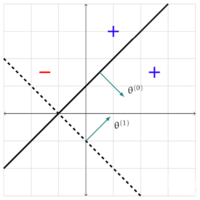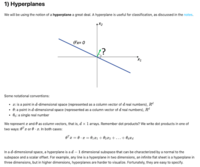And this was not part of a question/problem. The graph (from my OP) was used to explain an algorithm and I was not able to understand it.
Whatever it's part of, why not show us what was said about it? Sometimes a few words are worth a thousand (unexplained) pictures! So seeing the algorithm may help us figure this out.
Sorry for not being very clear. This is about Linear Classifiers, in Machine Learning. I am attaching a screenshot that explains the conventions.
View attachment 24568
Thanks.
Do they define what they mean by "offset"? Or is the term used in any other examples that might illustrate what they mean?
I came across this graph in a ML course.
View attachment 24540
The solid line is defined by theta = [1, -1] with an offset of 1. The dotted line is defined by theta = [2, 2] with an offset of 2.
I thought the lines would go through y-intercept 1 and point 1,-1 (and y-intercept 2 and point 2,2). But looks like that's not correct. Can anyone please tell me how these two lines were drawn?
Evidently this example is in two dimensions, and the column vectors are being represented as rows. The solid line, I suppose, might represent the equation
[1,−1]⋅x=k, where k is a constant number, likely called the "offset". (I'd think they would have written an equation somewhere that you could show, but this form is suggested by the illustration, which shows
θTx=0, presumably with offset 0.)
The picture doesn't appear to show the thetas accurately, as they appear to be the same length, and the second should be twice as long. But to check my guess, consider a couple points on each line. The first line would be 1x-1y=1 if I'm guessing right; but (0, 1) and (1, 2) both satisfy a different equation: 1*0-1*1=-1 and 1*1-1*2=-1. So maybe the offset is -k?
How about the second line, which would be 2x+2y=-2 if my new guess is right? The point (0,-1) satisfies 2*0+2*-1=-2, and (1,-2) satisfies 2*1+2*-2=-1.
Does that make sense? The line (hyperplane) with normal theta and offset k is
θ⋅x=−k, that is,
θ⋅x+k=0.



